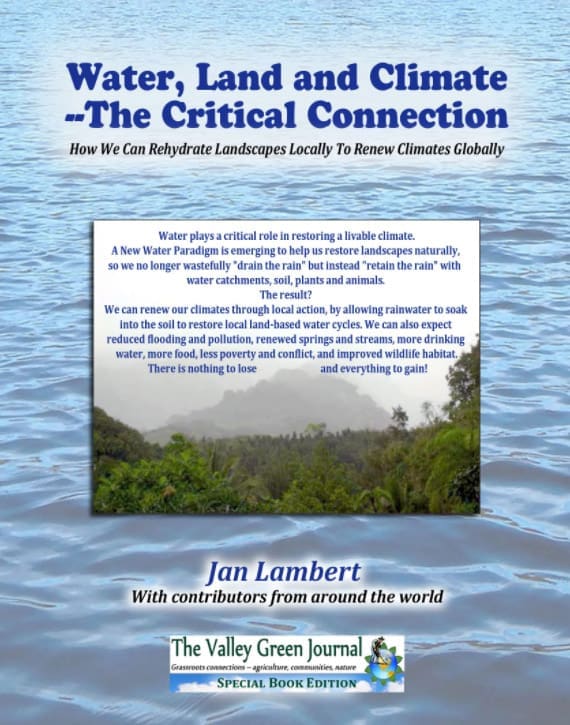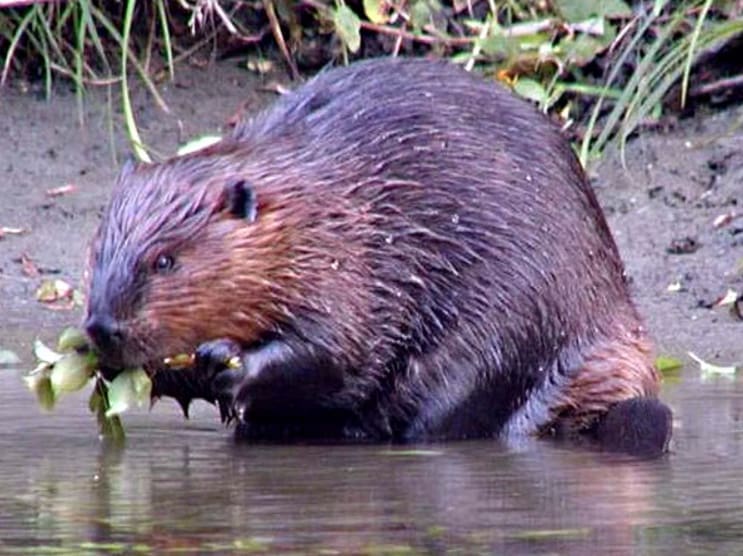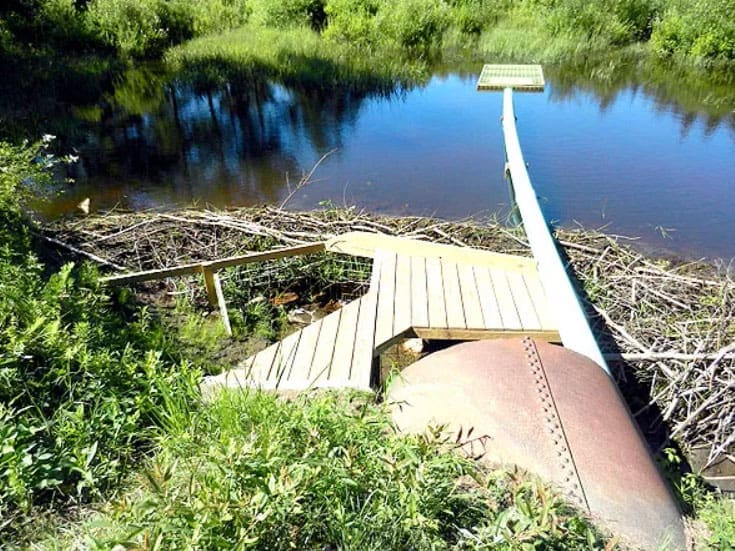This spring, Bio4Climate is sharing select excerpts from the late Jan Lambert’s book, Water, Land and Climate, The Critical Connection: How We Can Rehydrate Landscapes Locally To Renew Climates Globally. First published in 2015, her book introduces the transformative ideas of the New Water Paradigm, demonstrating how retaining, rather than draining, rainwater can restore local water cycles, renew ecosystems, and even help stabilize the global climate.
Reconnecting With Water: A Dedication to Beavers
Excerpt by Jan Lambert
Think about how our own bodies, which are mostly water, operate according to the laws of hydrology, the branch of science concerned with the properties of the earth’s water, especially its movement through cycles. Water we drink flows through our veins and other bodily systems. When we get too warm, glands produce sweat, which cools us down via the power of evaporation. We cannot survive very long without water. If we are dehydrated or we get too hot, we can be in serious trouble. Chronic dehydration is much more common although often unrecognized, and takes its toll on the overall health of many people.
The need of a constant supply of water for the human body—water flowing, evaporating, and condensing in cycles—is also the need of the landscapes that we call home, our particular portion of Planet Earth. Nature knows how to cycle and re-cycle water in a most efficient and elegant manner, not only in our own bodies, but in and through our landscapes and our local atmospheres, whether urban areas or countryside. If we interrupt those cycles and prevent rains from soaking into the land, our landscapes become dehydrated with unhealthy consequences. This is happening all over the globe, resulting in floods and droughts and contributing significantly to climate change.
Water cycles are central to nature’s design, and nature should be our ultimate guide to how we manage our landscapes for our own wellbeing as well as the ecology of the planet. The living soil, the forests and other plants, and animals, and the atmosphere all interact with water, which is arguably the most amazing substance on this planet. As it moves from liquid to vapor to solid and back again, water performs many feats to keep the planet alive. We need to understand, that it is essential that water be allowed to cycle in the ways nature has provided, in order to revive our ailing planet.
With nature’s wisdom in mind, I dedicate this book to beavers, those amazing creatures who, I am happy to say, are now common again in my region, the Northeast of the United States. Unfortunately beavers tend to get in the news and the general mindset, only because sometimes their dams flood roads and property. But it is important to understand that these animals are vital to the health of our landscapes, our water supplies, and our climates. Nowadays we realize why beavers are so important, after noting what happened after beavers were almost trapped out of existence by the 19th century here in the United States. The water tables dropped, floods and droughts increased, entire floodplains changed shape, and wildlife died out. This was all because the natural landscape was dependent on the water management of beavers.

Beavers build numerous small dams that hold water back, creating ponds and wetlands that are rich in biodiversity. Rainwater is collected and soaks into the ground, keeping the water table stocked with moisture that will tide the land over during a dry spell. Beavers stay in an area until their supply of wood has run out. While residing in an area they build multiple canals to help them move more wood to their dam and lodges.
This disperses water throughout the area and creates extensive wetlands. Rich wetland vegetation draws carbon dioxide from the air, capturing carbon into the ground which in turn holds more moisture and increases fertility. When the beavers finally move on, and their dams break down, what is left is a rich wet meadow which in turns supports a whole new diversity of plants and wildlife.
The moisture is still there, being transpired by the vegetation and cycling back into the atmosphere to form clouds and more rain over the region. And so the cycle goes around again and again, and the beavers are a major player in retaining precipitation in the landscape that starts the cycle anew.
Glynnis Hood, a wildlife biologist from Canada, has written a book, The Beaver Manifesto, in which she concludes, “There is something in that persistent drive to sustain water on the landscape that is a clue for our own survival as a species. Whether we take the time to learn from other species depends on our own adaptability and willingness to see our world and the resources within us in a new light.”
As you will see in this book, much great work is being done to retain rainwater in the land of forests, farms and cities. Various “green” methods allow water to cycle through soil and plants, and back into the atmosphere, instead of just draining directly into rivers.
In many cases the dam-building techniques of beavers are being copied by humans, so in a way we are becoming partners with beavers. May we all get a little better acquainted with these furry water experts and let them guide us in land and water restoration!
Water Cycles: In Concert with Nature
In nature water, plants, and soils all function together harmoniously with the atmosphere to absorb and regulate the flow of precipitation. Natural landscapes provide a “giant sponge” with ample vegetation and deep root systems and soil life that absorb water easily, replenish groundwater, and release a cooling cloud-forming water vapor, via plant transpiration, into the
atmosphere to later fall as rain. This is the essence of the regional, or small water cycle.
For centuries humankind has greatly interfered with local water cycles
by way of poor agricultural methods and deforestation that bare the soil. More recently has come massive urban and road development, where rain is often treated as a waste product termed “stormwater.” Urban areas and roads not only prevent stormwater from entering the ground with pavement and rooftops, but also drain the runoff directly into rivers, lakes, and oceans with
downspouts, storm drains, and pipes. Stormwater runoff is a major source of water pollution as well as contributing to flooding, drought, and diminished fresh water supplies.

Furthermore, less water into the land leads to less plant growth, the plants so greatly needed as prime regulators of climate. Human intervention is needed quickly, to “jumpstart” the process of restoration in seriously degraded or paved-over landscapes.
A critically important yet simple way for humanity to work with nature is being demonstrated around the globe by farmers, urban planners, foresters, and homeowners rediscovering the many benefits of allowing the rain and snow that falls on the land, to soak in where it falls. We all need water to survive and thrive, of course, so there is good reason for everyone on earth to be motivated in helping to direct the flow of precipitation into the land. By doing so we can curb erosion, pollution, floods, and droughts, replenish water tables, increase farm and ranch yields, increase property values, and create beautiful green areas for recreation and wildlife, all the while helping to moderate local climate.
Every one of us needs to be involved in welcoming precipitation, coaxing our local precipitation into the land by creating ” earth sponges” in concert with nature. Grassroots, local community action is needed. If enough citizens take simple actions, we can transform our barren, infertile, eroded and paved-over areas into delightfully luxuriant, vegetation-rich healthy pieces of landscape. Community actions add up
to global action.
The world is full of success stories of landscapes and waterscapes brought back to life through simple water-retaining practices. Whether in a tiny village in India or a large metropolis in America, the concept is the same: save the rain in the land on which it falls and the rewards will be great…

Jan Lambert was an environmental writer and editor of The Valley Green Journal, exploring the links between agriculture, nature, and communities. She collaborated with hydrologist Michal Kravčík to raise awareness about restoring water cycles, co-authoring “Water, Land and Climate – The Critical Connection,” which includes a climate action plan presented at COP21. As co-founder of Voices of Water for Climate, she championed local rainwater infiltration as a key solution to floods, droughts, and climate instability.





